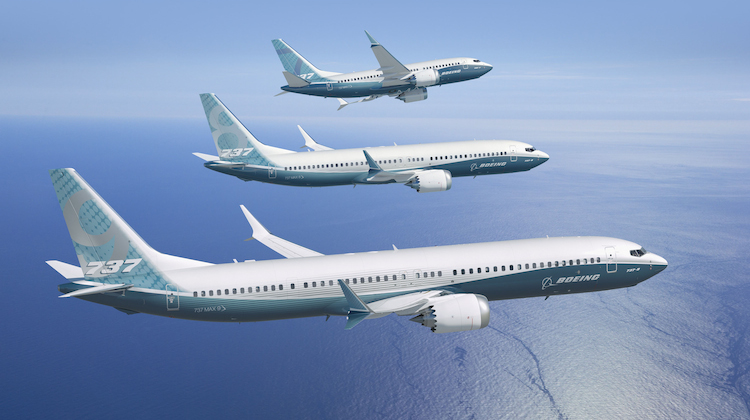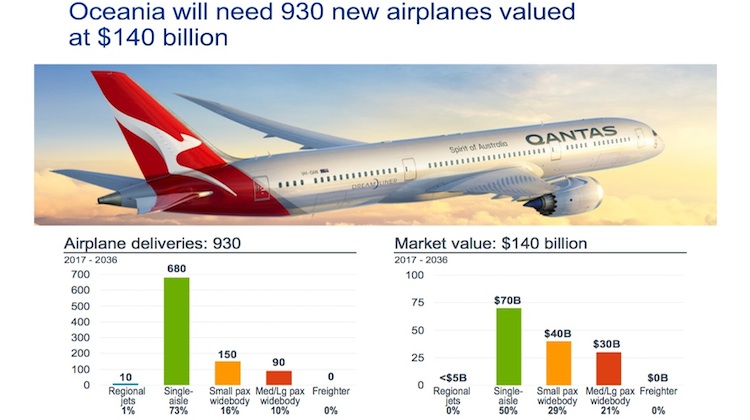
Boeing has downgraded its forecasts for new orders in Oceania over the next two decades, with the bulk of the reduction coming in the single-aisle segment featuring aircraft such as its own 737 and Airbus’s A320.
The manufacturer’s outlook is for airlines in the region – Australia, New Zealand and the nations of the South Pacific – to order 930 new aircraft worth $US140 billion over the next 20 years.
The estimate is a decrease of 90 aircraft from the 1,020 expected for Oceania in the 2016-2035 CMO.
The Oceania figures from Boeing’s Current Market Outlook (CMO) for 2017-2036 were shown during a presentation to journalists attending Qantas’s delivery ceremonies for its first 787-9 at Boeing’s Everett facility on Monday (US time).
The single-aisle category was cut from 800 in the prior year’s CMO to 680 aircraft, a reduction of 15 per cent.
By contrast, there was an increase in the small widebody segment (between 200-300 seats) from 130 aircraft to 150 aircraft.
There was also an increase in the regional jets segment, which Boeing does not compete in but offers a forecast for, from zero aircraft in the prior year’s CMO to 10 in the current outlook.
The medium/large widebody segment was unchanged from the previous year.

Boeing Commercial Airplanes managing director for product marketing and analysis Jim Freitas the emergence of next generation aircraft such as the 787 enabled airlines to launch more point-to-point routes with smaller gauge, lower cost equipment.
Airlines were also able to grow through adding new frequencies on existing routes and opening new markets rather than flying larger aircraft.
Freitas was also upbeat about the budget end of the market in Oceania.
“We do see strong growth in LCCs and the low-cost long-haul carriers,” Freitas told reporters.
Boeing expected the Oceania fleet to increase from about 580 aircraft today to 970 over the next 20 years, with some 540 aircraft replaced and 390 new aircraft joining the fleet for growth. Just 40 aircraft flying today will still be in the skies in two decades’ time, according to Boeing estimates.
“That indicates you have a fairly mature market in Oceania today,” Freitas said.
The bulk of the growth in passenger traffic for Oceania was likely to be for travel within the region, as well as to and from the key markets of the Middle East, China and South East Asia.
“We see the Oceania market has huge potential growth,” Qantas chief executive Alan Joyce said.
The forecast reduction in single-aisle orders comes as the Australian domestic market has experienced almost no growth over the past two years as Qantas and Virgin Australia have cut capacity in an effort to improve the bottom line, and better match the number of seats in the market with demand, amid the slowdown in the mining and resources sectors.
A recent report from the International Air Transport Association (IATA) said available seat kilometres (ASK) in the Australian domestic market had fallen an an annualised rate of about three per cent since the start of 2017, with demand also sluggish.
“Australia’s RPKs have ground to a standstill,” the IATA report said.
“The domestic Australia market barely grew in H1 2017.”
Qantas has said previously it intended to run a competition between the 737 MAX and A320neo at some future point for the replacement of its existing 737-800 fleet.
Meanwhile, Virgin Australia has deferred its order of 40 737 MAX narrowbodies to beyond the 2018/19 financial year.
And Air New Zealand expects to pick up the first of nine A320neos and four A321neos on firm order in the second half of calendar 2018, having announced it had pushed back the delivery date in August.















